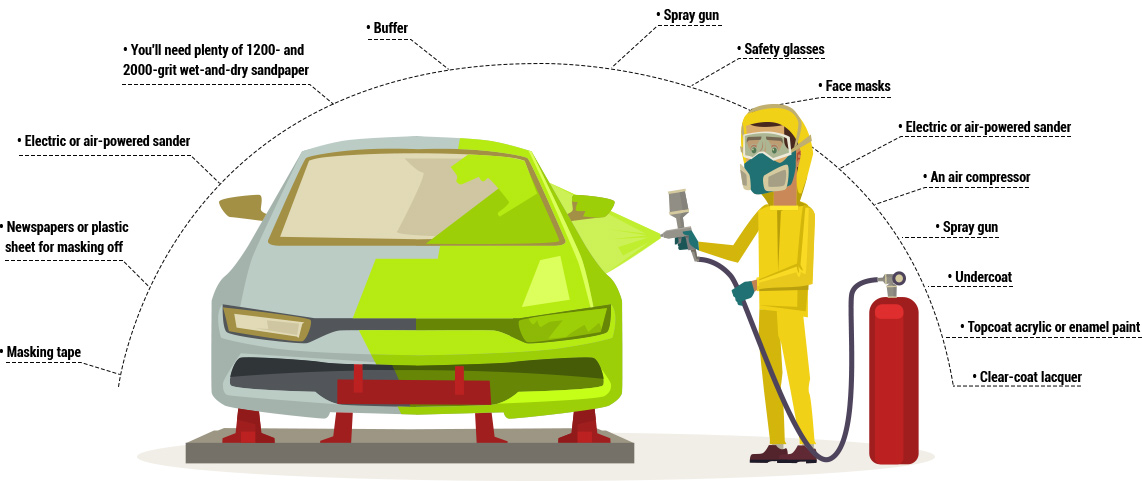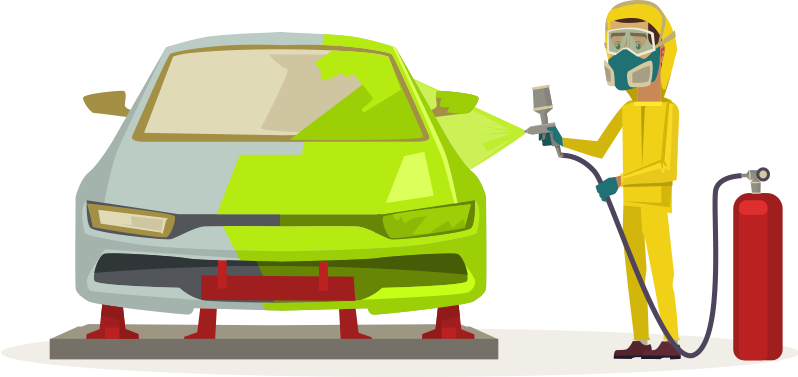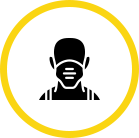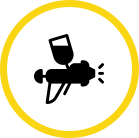We use cookies to make your experience better. To comply with the new e-Privacy directive, we need to ask for your consent to set the cookies. Learn more
HAVE A QUESTION? Price match request? Just call us in the shop...
Painting your car is a time-consuming job, so set aside a few days or a couple of weekends. It's best to use a shed to avoid the elements, but it can be done outside—weather permitting.

If you have or can hire a dust extractor, while not essential, will help keep the area clean.
If you want to match the original colour of your car, give the colour code, found on your car's compliance plate, to an auto paint shop. They will be able to match it.

Newspapers or plastic sheet for masking off
Electric or air-powered sander
You'll need plenty of 1200- and 2000-grit wet-and-dry sandpaper
Buffer
Spray gun
Safety glasses
Face masks
Electric or air-powered sander
An air compressor
Spray gun
Undercoat
Topcoat acrylic or enamel paint
Clear-coat lacquer
If you have or can hire a dust extractor, while not essential, will help keep the area clean.
If you want to match the original colour of your car, give the colour code, found on your car's compliance plate, to an auto paint shop. They will be able to match it.


Start sanding away using circular motions. You may have to sand corners and
crevices by hand. The best finish is achieved by sanding the entire panel back
to bare metal with a perfectly smooth finish. This can be time-consuming, with
each panel taking up to two hours to complete. If time is limited, you don't
have to go right back to bare metal. Just make sure you get a smooth, even
surface by finishing the last part with a fine-grade wet-and-dry sandpaper.
Wipe the whole surface down with a clean rag and thinners to remove dust, and
wait until residue from the thinners evaporates completely before continuing.

Mask up areas you don't want to paint using masking tape and newspaper or
plastic sheeting. Take the time to do this job well to avoid unsightly
overspray.
Mix the primer with thinners using the ratios recommended on the
paint can instructions. It will vary for different paints.
Before you start
painting for the first time, it's best to practice your spraying technique. Get
a cheap used car panel from a salvage yard, or use any piece of scrap steel you
have lying around. Hold the spray gun approximately 6 inches from the panel and
spray in a side-to-side sweeping motion. Apply the trigger only when you are
moving the spray gun. If you hold it continuously as you spray, the paint will
be thicker in the spots where you change direction, causing runs.
When you've
got your technique down, start applying the primer on the car, working from the
top down. Apply the primer in thin, even coats. It will usually take two or
three coats to cover the surface completely. Use the recommended drying times as
specified on the primer car instructions between coats. Take about 20 minutes to
an hour between recoating for the primer to cure.
The primed surface will
have a powdery finish, so use 2000 grit wet & dry sandpaper to lightly sand the
surface to a smooth, even finish. Clean the spray gun and wipe down the primed
surface with a rag slightly dampened with thinners. If you apply too much
thinner to the rag, it will strip the primer back.

As with the primer, mix the paint with thinners using the recommended ratios
on the paint can instructions. Apply the topcoat paint using the same spraying
techniques. Each coat will take about 10 minutes to apply per panel and between
20 minutes to an hour between recoating for the paint to cure.
Apply
three to four coats using the recommended drying time specified on the paint can
instructions between coats. Before applying the last coat, remove any powdery
residue with 2000-grit wet-and-dry sandpaper and wipe down with a clean rag.
Repeat the last two steps with the clear-coat lacquer.
Remove the masking
while the clear coat is still wet, being careful not to get any tape or paper
stuck on the wet paint. Let the clear coat cure for the recommended time.
Inspect the finished job for runs or imperfections. If you find any, sand back
affected area with 2000-grit wet-and-dry sandpaper and respray.
Buff
paint in circular motions with a buffer, being careful not to burn the paint by
holding the buffer in one spot too long.
With some practice, a methodical
approach, and persistence, a DIY paint job is achievable. The satisfaction you
get from doing it yourself is well worth the effort, and the money you will save
will astound you.